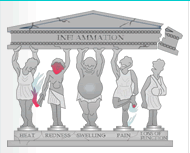About inflammation
Characteristics of inflammation
When you are injured, certain phenomena, including localized redness, heat, swelling, and pain, occur in the damaged area. These phenomena are normal symptoms of inflammation, and represent the natural responses of the local tissues involved. As inflammation progresses, widening of blood vessels, increased blood flow, leakage of blood elements, infiltration of leucocytes into the affected tissues, and nerve stimulation by newly generated chemical mediators occur; moreover, patients may experience all of these symptoms simultaneously. However, in most cases, these phenomena are transient, disappearing shortly thereafter. At the conclusion of inflammatory reactions, dead cells and contaminating bacteria are eliminated, and injured epithelial tissues of the skin are regenerated. Lost tissue is temporarily replaced by fibrous tissue, and the injured area is progressively restored.
Types of inflammation
Acute and chronic inflammation
The type of inflammation that disappears several days after onset is called "acute inflammation" and is distinguished from “chronic inflammation,” which is characterized by persistent symptoms.
Generalized inflammatory symptoms
Bacterial or viral infections in the deep layers of some internal organs cause generalized inflammatory symptoms, such as elevation of body temperature. In severe cases of such infections, shock can occur, with an accompanying reduction in blood pressure.
Inflammation can occur in all tissues and organs; however, inflammatory responses and the outcomes differ among organs. For example, there are significant differences in the symptoms and the structural changes to the organ observed during inflammation between the liver (hepatitis) and the lung (pneumonia).



